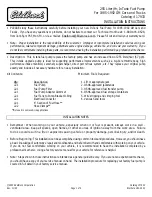
4-5. Operating other driving systems
185
D
ri
v
in
g
4
WARINING
◼
To ensure driving safety, the occupants in the car must fasten their seat belts!
◼
FCW is only a driver assistance system, so do not over-rely on it and the driver
must drive carefully.
◼
FCW only gives a warning of the danger of a collision, and the driver must
operate the brake pedal or steering wheel himself to prevent a collision.
◼
FCW may not recognize modified or decorated vehicles with special appearance.
◼
The FCW system obtains vehicle information by identifying the rear of the vehicle,
so the system does not alert to oncoming traffic in the opposite direction or to
vehicles crossing laterally in front of it.
◼
In complex traffic conditions, FCW may not recognize vehicles in time, resulting
in the delay of alarm.
◼
On curved roads, hilly roads or unusually bumpy roads, the system may not be
able to detect vehicles ahead and drivers must drive with caution.
◼
The FCW system is an alarm system, but cannot detect the vehicle in all
situations. For example, vehicles with heavily obscured rear ends, vehicles with
strange shapes (e.g. overloaded vehicles transporting trees), vehicles with
heavily damaged rear ends, etc.
◼
FCW may not be able to recognize narrow objects such as pedestrians or
bicycles.
◼
When rain, snow, ice, fog or dust block the sensors, the performance of the
system may be reduced or fail and the driver must drive with caution.
◼
The front windshield must not be modified or covered by any auxiliary equipment,
as this may result in reduced performance or failure of FCW.
◼
If the camera is displaced by a collision, the FCW function may be degraded or
malfunction, so the driver should calibrate the FCW system in time.
◼
Do not use an uncalibrated FCW system.
◼
For scenarios such as strong backlight, road reflection, and insufficient ambient
lighting, the FCW system may not work properly, so drivers should drive with
caution.
◼
If the chassis of the car in front is very high, or the goods protrude from the back
of the car, please pay attention to the possible dangerous situation.
◼
FCW may not be able to identify targets such as cyclists.
◼
The front bumper must not be painted, modified or covered by any auxiliary
equipment, as this may result in reduced performance or failure of the forward
millimeter wave radar sensor!
◼
Extreme weather such as severe snow, rain, ice, and dense fog may result in
reduced performance or failure of the forward millimeter wave radar sensor. In
this case, the driver should use the FCW system with caution.
◼
If the forward millimeter wave radar sensor is displaced by a collision, the FCW
may be degraded or malfunction, so the driver should calibrate the forward
millimeter wave radar sensor in time.
◼
Do not use the forward millimeter wave radar sensor that is not properly
calibrated.
Содержание E-HS9
Страница 2: ......
Страница 20: ...18 ...
Страница 65: ...1 3 Immobilizer system 63 Safety precautions 1 ...
Страница 211: ...4 6 Driving information 209 Driving 4 ...
Страница 305: ...6 4 Other in car equipment 303 In car equipment 6 ...
Страница 341: ...7 3 Self maintenance 339 Service and maintenance 7 ...
Страница 388: ...9 1 Specification Service data 386 List of abbreviations 386 Other information 385 ...
Страница 391: ...389 Charging station references Hood opening handle Charging port cover Tire pressure ...















































